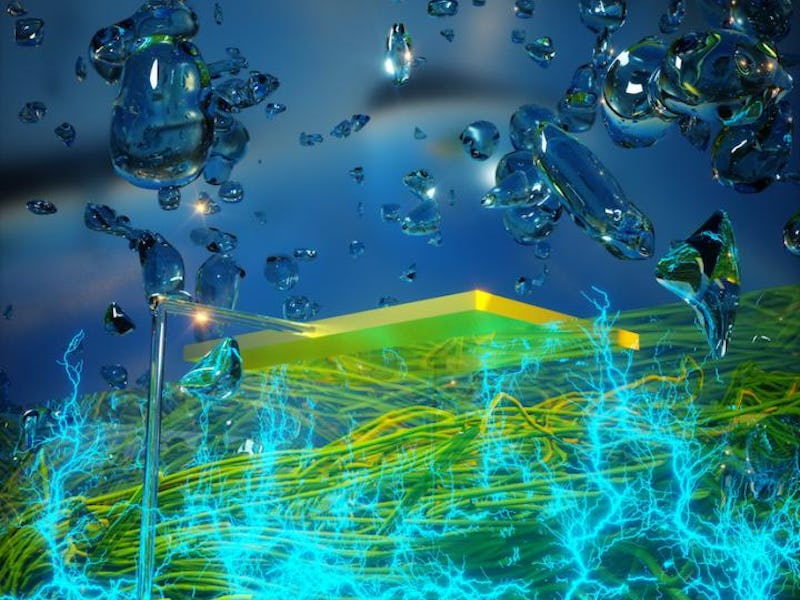The air around us contains energy. Researchers figured out how to capture it.
This is a groundbreaking concept, and it could change the renewable energy scene forever.

The Earth's atmosphere is filled with water, which occasionally takes the form of fog, clouds, or water vapor. The water also contains energy. The most visible and extreme example of this energy is lightning. A new study has revealed that we can capture this energy to create electricity, and this development could change the renewable energy scene forever.
As often happens in science, this new breakthrough happened on accident. Scientists at the University of Massachusetts, Amherst were working on using protein nanowires as sensors that could be put in wearable electronic devices. What they didn't expect was for the sensors to work before they even applied a current to them.
These protein nanowires are sustainably made using microorganisms, and they're less than 10 microns thick. These researchers discovered that by placing the nanowires between electrodes they could generate a charge. They're calling the device the "Air-gen." The study was just published in the journal Nature.
Derek Lovley, a microbiologist at the University of Massachusetts, Amherst and one of the authors of the study, tells Inverse that the water from the humidity in the air releases its charge as it is absorbed by the layer of wires.
"We just put a very thin layer of those wires on an electrode, then put a smaller electrode on top and that protein nanowire film absorbs humidity from the atmosphere... The water holds a charge that is released as the water is absorbed," Lovley says. "That's how we get an electric current."
They've only made a very small device that can power something like an LED light so far, but Lovley says the device is scalable, especially since they recently had another breakthrough.
"We had this bottleneck—I just couldn't produce very many wires," Lovley says. "We recently constructed a new microbe that makes it very easy to produce large quantities of wires. Now that we've solved that microbiological bottleneck, we can make a lot of wires to make larger devices."
Lovley says he was able to create a strain of E. coli that allows him to produce wires much more easily. He says this device could likely be scaled up to the point where you could create as much energy as you need with enough of them. The difference between a device like this and a solar panel is a solar panel is 2D—meaning it can only be scaled up by adding more panels to your array—but this device can be scaled up in three dimensions. It works at night and can even work inside.
"The Air-gen is a 3D technology because you can stack the devices on top of each other," Lovley says. "It works 24/7. It doesn't need the Sun. It also doesn't need wind. It can work indoors."
Lovley says the device works in pretty much any environment, regardless of how humid it is. He says it could even work in the Sahara Desert. It could be applied to smaller electronic devices like your phone to prevent it from losing its charge or applied on a large scale to power people's homes and more. Lovley says it's also not expensive to produce these devices.
See also: Anti-Solar Panel That Can Generate Power at Night May Be Ready by 2021
A device like this that can produce electricity at night, without wind and even inside a building could be a gamechanger in the renewable energy scene. The technology is new, but Lovley is confident it can be developed quickly now that they're managed to increase how many nanowires they can produce.
"Now we have this production strain microbial factory to make the wires," Lovley says. "That's going to really speed the whole process up."
Abstract: Harvesting energy from the environment offers the promise of clean power for self-sustained systems. Known technologies—such as solar cells, thermoelectric devices and mechanical generators—have specific environmental requirements that restrict where they can be deployed and limit their potential for continuous energy production. The ubiquity of atmospheric moisture offers an alternative. However, existing moisture-based energy-harvesting technologies can produce only intermittent, brief (shorter than 50 seconds) bursts of power in the ambient environment, owing to the lack of a sustained conversion mechanism. Here we show that thin-film devices made from nanometre-scale protein wires harvested from the microbe Geobacter sulfurreducens can generate continuous electric power in the ambient environment. The devices produce a sustained voltage of around 0.5 volts across a 7-micrometre-thick film, with a current density of around 17 microamperes per square centimetre. We find the driving force behind this energy generation to be a self-maintained moisture gradient that forms within the film when the film is exposed to the humidity that is naturally present in air. Connecting several devices linearly scales up the voltage and current to power electronics. Our results demonstrate the feasibility of a continuous energy-harvesting strategy that is less restricted by location or environmental conditions than other sustainable approaches.